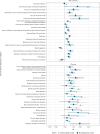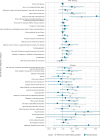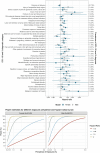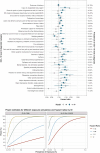Familial confounding in the associations between maternal health and autism
- PMID: 39891002
- PMCID: PMC11922763
- DOI: 10.1038/s41591-024-03479-5
Familial confounding in the associations between maternal health and autism
Abstract
Evidence suggests that maternal health in pregnancy is associated with autism in the offspring. However, most diagnoses in pregnant women have not been examined, and the role of familial confounding remains unknown. Our cohort included all children born in Denmark between 1998 and 2015 (n = 1,131,899) and their parents. We fitted Cox proportional hazard regression models to estimate the likelihood of autism associated with each maternal prenatal ICD-10 diagnosis, accounting for disease chronicity and comorbidity, familial correlations and sociodemographic factors. We examined the evidence for familial confounding using discordant sibling and paternal negative control designs. Among the 1,131,899 individuals in our sample, 18,374 (1.6%) were diagnosed with autism by the end of follow-up. Across 236 maternal diagnoses we tested (prevalence ≥0.1%), 30 were significantly associated with autism after accounting for sociodemographic factors, disorder chronicity and comorbidity, and correction for multiple testing. This included obstetric, cardiometabolic and psychiatric disorders (for example, diabetes in pregnancy (hazard ratio (HR) 1.19, 95% confidence interval (CI) 1.08-1.31) and depression (HR 1.49, 95% CI 1.27-1.75)), previously shown to be associated with autism. Family-based analyses provided strong evidence for familial confounding in most of the observed associations. Our findings indicate pervasive associations between maternal health in pregnancy and offspring autism and underscore that these associations are largely attributable to familial confounding.
© 2025. The Author(s).
Conflict of interest statement
Competing interests: V.K. is currently employed by Takeda Pharmaceutical Company outside of the submitted work. The other authors declare no competing interests.
Figures








References
-
- Xiang, A. H. et al. Association of maternal diabetes with autism in offspring. JAMA313, 1425–1434 (2015). - PubMed
-
- Croen, L. A., Grether, J. K., Yoshida, C. K., Odouli, R. & Van de Water, J. Maternal autoimmune diseases, asthma and allergies, and childhood autism spectrum disorders: a case–control study. Arch. Pediatr. Adolesc. Med.159, 151–157 (2005). - PubMed
-
- Atladóttir, H. O. et al. Maternal infection requiring hospitalization during pregnancy and autism spectrum disorders. J. Autism Dev. Disord.40, 1423–1430 (2010). - PubMed
MeSH terms
Grants and funding
- HD098883/U.S. Department of Health & Human Services | NIH | Eunice Kennedy Shriver National Institute of Child Health and Human Development (NICHD)
- R01 MH124817/MH/NIMH NIH HHS/United States
- T32 MH122394/MH/NIMH NIH HHS/United States
- T32-MH122394/U.S. Department of Health & Human Services | NIH | National Institute of Mental Health (NIMH)
- R01 HD098883/HD/NICHD NIH HHS/United States
LinkOut - more resources
Full Text Sources

